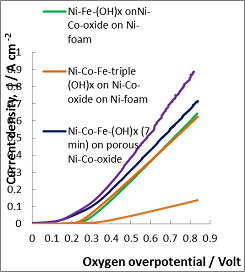Shahed U M Khan
Duquesne University, USA
Title: Electrochemically fabricated substrate dependent smart electrocatalysts Ni-Fe double and Ni-Co-Fe triple hydroxides for efficient water splitting to oxygen and hydrogen
Biography
Biography: Shahed U M Khan
Abstract
Water electrolysis is a significant method that can utilize renewable energy to produce hydrogen; a fuel that can transform earth towards a clean energy future. Activity of electrocatalysts for water oxidation is fundamental for energy conversion technologies including integrated solar power generating devices and water electrolyzers. In this study we have electrochemically fabricated the naturally abundant and stable electrocatalysts Ni-Fe-double hydroxides, Ni-Fe-Co-triple hydroxides, for efficient splitting of water to oxygen and clean fuel hydrogen. Oxygen-evolution activities of these electrocatalysts were examined in an alkaline solution of KOH. We focused in determining electro-catalytic activity of these double and triple hydroxides electrodeposited on different substrates such as Ni-foam, electrodeposited Ni-Co-oxide on Ni-foam and pressed porous Ni-Co oxide under varying electrodeposition bath composition, electrodeposition time and electrodeposition current and potentials. We found that Ni-Fe-Co triple hydroxide electrodeposited for total of 10 min on pressed porous Ni-Co-oxide sheet acted as a superior electrocatalyst for oxygen evolution reaction during water splitting reaction. This electrocatalyst generated a current density of ~ 100.0 mA cm-2 at an oxygen overpotential of 0.270 volt (= 1.5-volt vs RHE) in 1.0 M KOH at electrolyte temperature of 25oC. However, this triple hydroxide deposited for 7 min generated 81.0 mA cm-2 at the same overpotential, electrolyte concentration and temperature. The synergetic effect of multiple hydroxides and the substrates was mostly responsible for such enhanced electro-catalytic activity. The effect of higher electrolyte temperature was also found to have important role in enhancing the current density because of exponential dependence of reaction rate on temperature. The surface morphology and the composition of these electrocatalysts were determined using the scanning electron microscope (SEM) and energy dispersive spectroscopic (EDS) data.

Figure 1: The oxygen evolution current density versus oxygen overpotential on Ni-Fe-double hydroxides and Ni-Co-Fe-triple hydroxides electrodeposited on various substrates such as Ni-foam, Ni-Co-oxide on Ni-foam and on pressed porous Ni-Co-oxide in 1 M KOH at electrolyte temperature of 25oC measured using the scan rates of 5 mV/sec.

